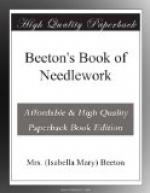This illustration shows a sampler which will be found useful for learning to embroider letters for marking linen. The material used is cambric muslin or fine linen. Work the embroidery with white embroidery cotton, red cotton, or black silk. The thick parts of the letters are worked in slanting satin stitch and back stitch; the outlines of the stitched parts are worked in overcast, as well as the fine outlines of the letters and all the fine outlines of the patterns. The monograms and crowns are worked in a similar manner. Work button-hole stitch round the outside of the sampler. The letters and crowns may, of course, be employed for other purposes.
* * * * *
361.—Alphabet (Capitals).
Material: Messrs. Walter Evans and Co.’s Embroidery Cotton No. 20
This effective alphabet is very easily worked, the stitches employed being raised and veined satin stitch, and overcast. The raised dots are worked in satin stitch, care being taken to preserve their position in the centre of each open space.
[Illustration: 361.—Alphabet (Capitals).]
* * * * *
MONOGRAMS AND INITIALS.
* * * * *
[Illustration: 362.—Alice.]
362.—Alice.
Material: Messrs. Walter Evans and Co.’s Embroidery Cotton No. 20.
The letters of this name, except the initial letter, are very simple, being worked in plain satin stitch, while the initial letter is worked in raised satin stitch, point de poste, and overcast.
363.—Amalie.
Materials: Messrs. Walter Evans and Co.’s Embroidery Cotton Nos. 16 and 20.
[Illustration: 363.—Amalie.]
The highly-ornate initial of this name is not difficult to work, requiring only great regularity and evenness in embroidering the tendrils and eyelet-holes. The veinings of the letter must be carefully defined. The remainder of the name is executed in plain satin stitch, a few eyelet-holes being introduced.
“Amalie” can easily be altered into “Amelia” by changing the place of the a and e. In the centre of each letter a large eyelet-hole is placed; smaller eyelet-holes of graduated sizes occupy parts of the overcast scrolls, which should be worked with No. 20 cotton. The initial letter is worked in raised satin stitch.
[Illustration: 364.—Amy.]
364.—Amy.
Material: Messrs. Walter Evans and Co.’s Embroidery Cotton No. 16.
This pretty name is worked in delicately raised satin stitch and point de pois; the dots in dotted satin stitch, and the elegant little design beneath is worked in point russe.
365.—Annie.
Material: Messrs. Walter Evans and Co.’s Embroidery Cotton No. 16.
[Illustration: 365.—Annie.]




